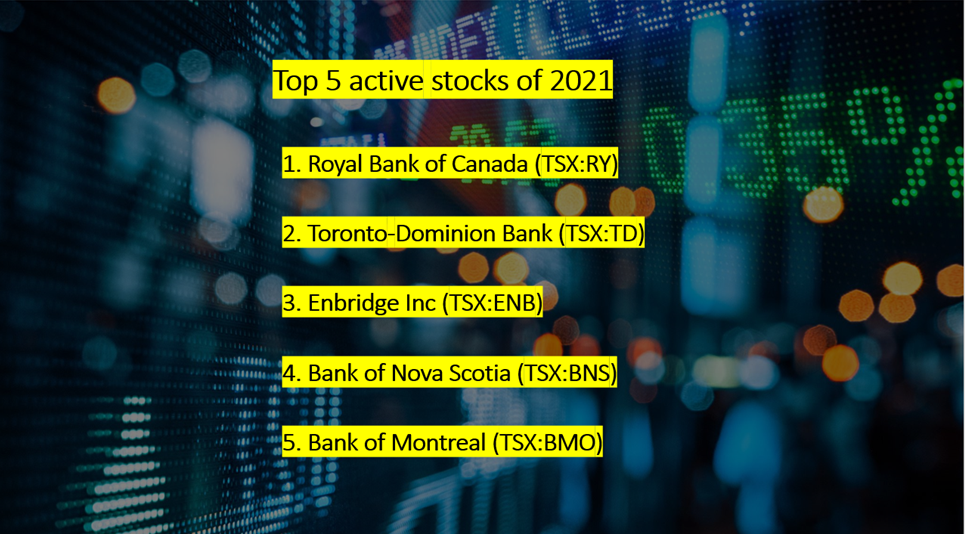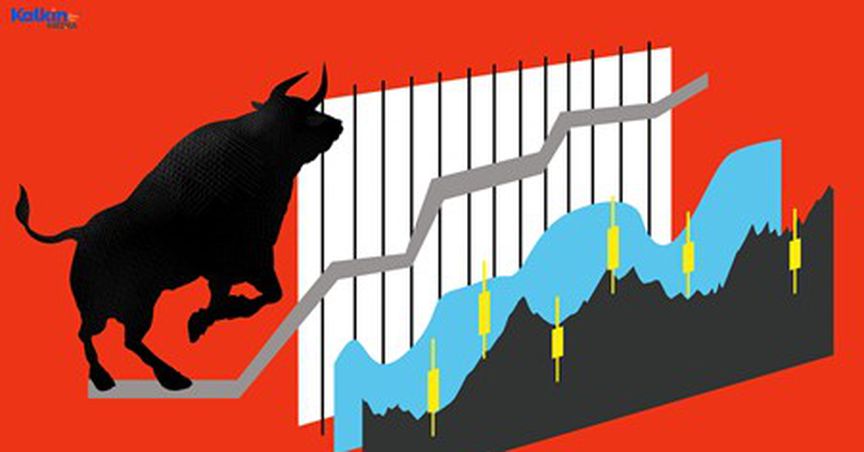Highlights
- The S&P/TSX Composite Index has surged by about 20 per cent.
- The most actively traded stocks on the Canadian bourse has been from the financial and energy sectors.
- The TSX’s financial sector has jumped by nearly 29 per cent, while the energy sector has grown by a notable 88 per cent on a year-to-date (YTD) basis.
Year 2021 is about to end, and this year so far, the S&P/TSX Composite Index has surged by about 20 per cent. As it happens, the most actively traded stocks on the Canadian bourse has been from the financial and energy sectors.
Notably, the TSX’s financial sector has jumped by nearly 29 per cent year-to-date (YTD), while the energy sector has grown by about 88 per cent.
So, let us look at some of the most actively traded stocks that Canadian investors can explore.

Image source: © 2021 Kalkine Media
Image description:
1. Royal Bank of Canada (TSX:RY)
The banking stock delivered a return of approximately 24 per cent year-to-date (YTD), having closed at C$ 129.73 apiece on Thursday, November 9.
RY stock clocked a 52-week high of C$ 134.23 on August 25, 2021.
The bank recorded a year-over-year (YoY) surge of 40 per cent to C$ 16.1 billion in the fourth quarter of the fiscal year 2021. It is also supposed to pay a quarterly dividend of C$ 1.20 apiece on February 24 next year, up from the previous dividend payment of C$ 1.08.
Royal Bank of Canada currently holds a 52-week average daily traded value of C$ 465 million.
Also read: Which Canadian penny stocks would be a smart buy?
2. Toronto-Dominion Bank (TSX:TD)
TD stock zoomed by nearly 16 per cent in three months and soared by almost 33 per cent this year.
On December 9, its stock closed at C$ 95.44 apiece, slightly down from its previous close. It hit a 52-week high of C$ 96.75 recently, on December 2, 2021.
Toronto-Dominion Bank reported a net income of C$ 3.78 billion in Q4 FY2021, down from C$ 5.14 billion in the same quarter a year ago. The bank is scheduled for a quarterly dividend payment of C$ 0.89 apiece on January 31, 2022, up from C$ 0.79 apiece delivered in the previous quarter.
Toronto-Dominion Bank holds a 52-week average daily traded value of C$ 453 million.
3. Enbridge Inc (TSX:ENB)
Though the energy stock plunged by over five per cent in the past three months, it marked a YTD gain of approximately 18 per cent.
ENB stock closed at C$ 48.04 apiece on December 9, a drop of more than two per cent from the previous close. It achieved a 52-week high of C$ 54 on November 5, 2021.
The midstream energy firm recorded adjusted earnings of C$ 1.2 billion in Q3 FY2021, up from C$ 1 billion a year ago. It also increased the quarterly dividend payment of C$ 0.835 to C$ 0.86 apiece, scheduled for March 1 next year.
Enbridge Inc has a 52-week average daily traded value of C$ 403 million.
4. Bank of Nova Scotia (TSX:BNS)
BNS stock expanded by almost 25 per cent on a YTD basis. The bank scrip closed at C$ 85.80 apiece on December 9, slightly up from its previous close. It established a new 52-week high of C$ 85.88 during the session.
BNS posted a net income of C$ 2.55 billion in the fourth quarter of fiscal 2021, up from C$ 1.89 billion in the same quarter a year ago.
The bank also declared an increased quarterly dividend of C$ 1 apiece, payable on January 27.
Bank of Nova Scotia has a 52-week average daily value traded of C$ 311 million.
5. Bank of Montreal (TSX:BMO)
BMO stock delivered a YTD return of over 42 per cent. After recording a day high of C$ 138.29, its stock closed at C$ 137.83 apiece on December 9, slightly down from its previous close.
Its net income grew by 36 per cent YoY to C$ 2.15 billion in the fourth quarter of fiscal 2021. It also increased its quarterly dividend payment of C$ 1.06 apiece to C$ 1.33 apiece, payable on February 28 next year.
Bank of Montreal has a 52-week average daily traded value of C$ 272 million.
What are the most actively traded Canadian Stocks in 2021?
Bottom line
The financial and energy sectors are two extremely important spaces in Canada that contribute the most to the benchmark index. Presently, they consist of more than 32 per cent and about 13 per cent in the S&P/TSX composite index, respectively.
Also read: Which Canadian bank stocks to buy as dividends go up?



